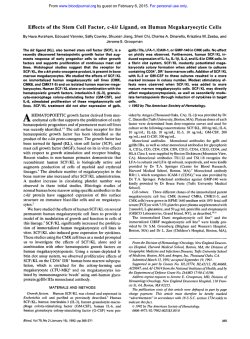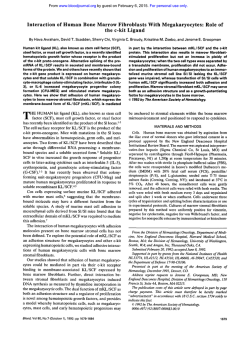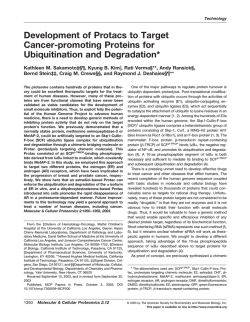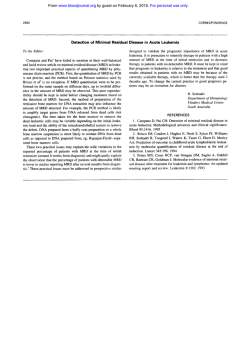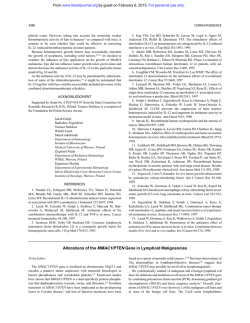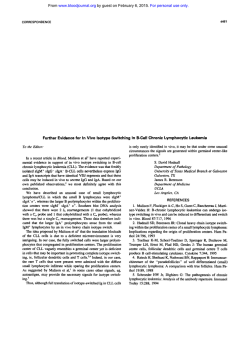
Stem Cell Factor and Interleukin-7 Synergize to Enhance
From www.bloodjournal.org by guest on February 6, 2015. For personal use only. Stem Cell Factor and Interleukin-7 Synergize Early Myelopoiesis In Vitro to Enhance By Cecilia Fahlman, Heidi K. Blomhoff, Ole P. Veiby, Ian K. McNiece, and Sten E.W. Jacobsen Interleukin-7 (IL-71 has been shown to be a critical factor in murine lymphoid development. It stimulates pre-B cells to divide in the absence of stroma cells and it is an important growth regulator of immature and mature T cells. IL-7 has been shown to synergize with stem cell factor (SCF) to provide a potent growth stimulus for pre-B cells. However, the combined effects of IL-7 and SCF on murine primitive hematopoietic cells in vitro have not been established. In thepresent study, the effects of recombinant rat (rr)SCF and recombinant human (rh) IL-7on primitive murine bone marrow progenitors (Lin-Scal+) wereinvestigated in single-cell cloning experiments. rhlL-7 alone had no proliferative effect on Lin-Scal+ cells, but in a dose-dependent manner directly enhanced rrSCF-induced colony formation, with an average increase in colony numbers of 2.7-fold. Interestingly, the cells formed in response to SCF and IL-7 were predominately mature granulocytes. Thus, SCF and IL-7 synergizeto stimulate early myelopoiesis in vitro. 0 1994 by The American Society of Hematology. T eration and differentiation of murine Lin-Scal' bone marrow progenitor cells. Lin-Scal' cells have been shown to be highly enriched in cells capableof long-term repopulation of all cell lineages in the blood, and less than 100 of these irradiated Weshow cellscan rescue 50% of lethally here for the first time that SCF and IL-7 directly synergize on these cells to promote their proliferation and primarily myeloid development. HE PROLIFERATION and differentiation of hemato- poietic stem cells leads to the production ofmature blood cells.'-3 Thisprocess is regulated by a complex system of growth factors and mediators of cell to cell In mice, interleukin-7 (IL-7) has been shown to be an essential growth factor forB-cell de~elopment."'~ It acts as a proliferative stimulus on a subset of pre B cells that express pH chain in thecytoplasm(Cp'). Pro-B cells (cellswithIg genes in germline configuration) have been proposed to be dependent on contactwith stromal cells forproliferation."." Stem cell factor (SCF), also known as kit-ligand and mast cell growth factor,""' is a stromal cell-derived factor that can synergize with IL-7 to stimulate theproliferation of C p + pre-B cells."~" Some studies havesuggested that pro-Bcells, although expressing receptors for both IL-7 and SCF, donot grow in response to thesesolublefactors alone, requiring direct contactwith stromal cells.13~'J.2"~21 However, it has previously been shown that SCF plus IL-7 can act in synergy to stimulatethe proliferation and differentiation of pro-B cells to pre-B cells." In contrast, a recent study suggested that the combination of SCF and IL-7 does not stimulate the expansion ordifferentiation of early B-cell precursors before the expression of the B220 antigen," thought to identify all B-lineage-committed cells in the murine bone marrow.24 We have recently observed a novel role for IL-7in myelopoiesis, in that IL-7 in synergy with colony-stimulating factors (CSFs) can directly stimulate the formation of mature myeloid progeny from primitive murine progenitors." Because no previous studies have examined the ability of SCF plus IL-7 to affect the growth of immature hematopoietic progenitors, the present studies weredesigned to evaluate the direct effects of this growth factorcombination on prolifFrom the Department of Immunology, Institute for Cancer Research, The Norwegian Radiumhospital, Oslo, N0rwa.y; Nycomed Bioreg, Oslo, Norway; and Amgen Inc, Thousand Oaks, CA. Submitted October 5, 1993; accepted April 25, 1994. Supported by the Norwegian Cancer Society. Address reprint requests to Sten E.W. Jacobsen, MD, PhD, Department of Immunology, Institute for Cancer Research, The Norwegian Radium Hospital, Montebello, 0310 Oslo, Norway. The publication cost., ofthis article were defrayed in part by page charge payment.This article must therejbre be hereby marked "advertisement" in accordance with 18 U.S.C. section 1734 solely to indicate this fact. 0 1994 by The American Society of Hematology. 0006-4971/94/X405-00I 7$3.00/0 1450 MATERIALS AND METHODS Enrichment and purijication of murine bone marrow cells. Linbonemarrow cells were isolated from normal C57BL mice, according to a previously described protocol.' Briefly, low-density bone marrow cells were isolated by density centrifugation on a lymphocyte separation medium (Nycomed, Oslo, Norway). Cells were washed twice in Iscove's modified Dulbecco's medium (IMDM; GIBCO, Paisley, UK) and resuspended in IMDM supplemented with 20% fetal calf serum (FCS; Sera lab, Sussex, UK), 100 U/mL penicillin, and 3 mg/mL L-glutamine (complete IMDM). The cells were incubated at 4°Cfor 30 minutes in a coctail of predetermined optimal concentrations of antibodies: RA3-6B2 (B220 antigen; Pharmingen, San Diego, CA), RB6-8C5 (GR-1 antigen; Pharmingen), MAC-I (Serotec, Oxfordshire, UK), Lyt-2 (CD8; Becton Dickinson & CO, Sunnyvale, CA), and L3T4 (CD4; Pharmingen). Cells were washed twice and resuspended in complete IMDM. Sheep antirat IgG (Fc)conjugated immunomagnetic beads (Dynal, Oslo, Norway) were added at a cel1:bead ratio of 1:20 and incubated at 4°C for 30 minutes. Labeled (Lint) cells were removed by a magnetic particle concentrator (Dynal) and Lin- cells were recovered from the supernatant, The Lin- cells were further purified on the basis of Sca- 1 expression, aspreviouslydescribed.'.'' Briefly, 4 to 6 X IO' Lin- cells were resuspended per milliliter of complete IMDM and incubated for 30 minutes on ice with either fluorescein isothiocyanate (FITC)conjugated rat antimouse Ly-6A/E antibody (Pharmingen) or an isotype-matched control antibody. The cells were washed twice, and Lin-Scal' cells were collected on a Coulter Epics Elite Cell Sorter (Coulter Electronics, Hialeah, FL) equipped with a 488 nm tuned argon laser set to give a power of 15 mW, with a rate of 1,500 to 2,000 cellslsecond. Lin- cells falling into median right angle scatter and median to high forward scatter were analyzed for Sca-l expression, and cells falling into both regions were selected. Light scatter was collected through a 488 nm band pass filter and HTC fluorescence was collected through a 525-nm band pass filter. The final recovery of Lin-Scal cells was 0.05% to 0.1% of the unfractionated bone marrow. Reanalysis of sorted Lin-Scal+ cells showed reproducibly a purity greater than 95%. Growthfactors. Purified recombinant human (rh) IL-7 was kindly supplied by Dr Steven Gillis (Immunex Corp. Seattle, WA). Recombinant rat (TT) SCF was expressed in Escherichia coli and + Blood, Vol 84, No 5 (September I),1994: pp 1450-1456 From www.bloodjournal.org by guest on February 6, 2015. For personal use only. MYELOPOIETIC EFFECTSOFSCF 1451 AND IL-7 Table 1. Direct Proliferative Effects of SCF and IL-7 on Lin-Scal+ Bone Marrow Cells Table 2. Direct ProliferativeEffects of SCF, IL-7, and GM-CSF on Lin-Scal- Bone Marrow Cells No. of Positive WellsI300 No. of Positive Welld300 Growth Factor 7 1 1 1 1 2 2 2 2 3 3 3 3 Medium 1 SCF 2 IL-7 5 SCF +6IL-7 Medium SCF IL-7 SCF IL-7 Medium 5 SCF 7 IL-7 SCF + IL-7 + 9 Cells/ Well Exp. 1 Exp. 2 Exp. 3 0 0 0 0 0 2 0 0 4 0 10 0 0 3 0 7 0 0 5 0 12 0 0 16 0 11 0 26 Exp. 4 Exp. 5 0 3 0 7 0 6 0 15 0 10 0 19 0 3 0 7 0 5 0 14 0 14 0 34 P Value Growth Factor CellshVell Exp. 1 <.05 SCF IL-7 SCF + IL-7 GM-CSF 1 1 1 1 0 0 0 6 Exp. Exp. 2 3 Exp. 0 0 0 9 1 0 1 8 4 0 0 0 10 Lin-Scal- cells were separatedas described in Materials and Methods and plated in Terasaki plates at a concentrationof 1 cell per well in 20 pL complete IMDM. BothSCF and IL-7 were used at 100 ng/mL and GM-CSF was used at20 ng/mL. Wells were scored for cell growth (>IO cells) after 12 days of incubation at 37°C in 5% CO? in air. The results from four separate experiments are shown. <.05 <.05 Lin-Scal' cells were separated as described in Materials and Methods and plated in Terasaki plates at a concentrationof 1,2, or 3 cells per well in 20 pL complete IMDM. IL-7 and SCF were both used at predeterminedoptimalconcentrationsof 100 ng/mL.Wellswere scored for cell growth ( > l 0 cells) after12 days of incubation at 37°C in 5% CO2 in air. The results from five separate experiments are shown. Statistical significance ( P value)wasdeterminedusingtheMannWhitney test. purified to homogeneity, as described previou~ly.~' The specific activity of rrSCF was 3 X 105 U/mg, where 1 U is defined as the amount of rrSCF stimulating half-maximal thymidine uptake by MC9 cells.2R Recombinant murine granulocyte-macrophage-CSF (rmGM-CSF) was from Amgen Inc (Thousand Oaks, CA). Single-cell prolifermion assays. Lin-Scal+ cells were seeded in Terasaki plates (Nunc, Kamstrup, Denmark) at a concentration of 1 cell per well in 20 pL complete IMDM. In addition, 2 and 3 cells per well were seeded in 20 pL of complete IMDM. Wells were scored for cell growth ( > I O cells) after 12 days of incubation at 37°C in 5 8 CO,. Phenotyping of cells. Lin-Scal' cells were cultured at 5 X lo3 cells/mL in complete IMDM with SCF (100 ng/mL) or a combination of SCF and IL-7 (100 ng/mL) for 12 days at 37°C in 5% CO, in air. ( I ) Approximately 5 X IO4 cells were cytocentrifuged onto glass slides and stained with Giemsa. The content of granulocytes, macrophages, and undifferentiated blast cells was determined by microscopic examination. (2) Cells were stained for cell-surface antigen expression by standard immunofluorescence techniques using monoclonal antibodies (MoAbs) at predetermined optimal concentrations. Granulocyte-l (GR- I ; Pharmingen) expression was shown by FITC-conjugated antirat IgG (Cappel, Durham, NC). Ly-5 (B220; Pharmingen) was directly conjugated to phycoerythrin (PE). Isotypematched MoAbs with irrelevant specificity served as negative controls. Fluorescence was analyzed on a FACScan flow cytometer (Becton Dickinson). Lin-Scal' cells were seeded in Terasaki plates at a concentration of 1 cell per well in 20 FL complete IMDM. After 12 to 14 days of growth, individual colonies were harvested and cytocentrifuged onto glass slides and stained with Giemsa. RESULTS T I SCF and IL-7 directly synergize to enhance the proliferation of Lin-Scal+, but not Lin-Scal", bone marrow progeni- Table 3. Effects of SCF and IL-7 on Differentiation of Lin-Scal+ Bone Marrow Cells CellslmL Growth Factor 1.5 0.75 0 0,001 0.01 0,l 1 10 100 IL-7 (ng/nl) Fig 1. DoseresponseofIL-7 on SCF-stimulated proliferation of Lin-Seal+ progenitor cells. Lin-Scal' cells were separated asdescribed in Materials and Methods, plated at a density of 2 cells per well in Terasaki plates in complete IMDM supplemented with SCF (100 nglmLI, and exposed to increasing concentrationsof IL-7. Wells were scored for growth ( > l 0 cells) after 12 days of incubation at 37°C in 5% CO2in air. Resultsare the mean (+SEMI of three separate experiments with duplicate determinations. Experiment 1 SCF SCF + IL-7 Experiment 2 SCF SCF IL-7 Experiment 3 SCF SCF IL-7 (x105t % Granulocytes % Macrophages % Blasts 93 87 5 5 2 8 95 88 6 4 6 4.8 1 + 3.4 + 1.1 3.9 3 94 85 3 7 8 Lin-Scal' cells were isolated as described in Materials and Methods and seededin liquid culture at 5,000 cells/mL in complete IMDM. Cultures were stimulated with SCF (100 ng/mL) or SCF plus IL-7 (100 ng/mL) for 12 days at 37°C in 5% CO, in air. Cell morphology was determined after Giemsa staining of cytospin preparations. "Blasts" denotes cells with undifferentiated morphology. From www.bloodjournal.org by guest on February 6, 2015. For personal use only. 1452 FAHLMAN ET AL Fig 2. Morphology of cells from day-12 liquid cultures of Lin-Scal' bone marrow cells. Lin-Scal' cells were isolated as described in Materials and Methods andseeded in liquid cultures at5,000 cells/mL in complete IMDM. Cultures were stimulated with SCF 1100 nglmLl (A) or SCF plus IL-7 (100 ng/mL) (B) for l 2 days at 37°C in 5% CO2 in air, cytocentrifuged, and stained with Giemsa. Cytospin preparations were photographed at x 1,000 magnification. From www.bloodjournal.org by guest on February 6, 2015. For personal use only. 1453 MYELOPOIETIC EFFECTS OF SCF AND IL-7 tor cells. To determine whether SCF plus IL-7 could synergize to stimulate immature progenitors, Lin-Scal+ cells were isolated and cultured in the presence of SCF and/or IL-7. Because IL-7 has been shown to potently induce cytokine secretion from m0nocytes,2~Lin-ScaI+ cells were grown as single isolated cells to determine the direct effects of IL-7 on the progenitor cells. IL-7 alone didnot stimulate any colony formation of Lin-Scal+ cells (Table 1). In agreement with other^,^.^ SCF alone induced a small number of colonies (Table l). In five separate experiments, IL-7 at 100 ng/mL enhanced SCF-induced colony formation from 2.3- to 5-fold. A similar enhancement was observed when 2 or 3 cells were plated per well (Table 1). The SCF-stimulated colony formation was enhanced by IL-7 in a dose-dependent fashion, with maximum enhancement observed at 100 ng/mL of IL-7 (Fig 1) and an EDSo of 1 to 10 ng/mL. Higher concentrations of IL-7 did not further enhance the number of colonies formed by Lin"Sca 1 cells when stimulated by SCF, because in three separate experiments a mean of 7 (51) colonies were formed in response to SCF alone, and IL-7 at 100 ng/ mL enhanced the number of colonies to a mean of 18 (? 1 ), whereas 17 (52) and 14 (?2) colonies were formed in the presence of 200 ng/mL and 500 ng/mL of IL-7, respectively. The size of the colonies generated by Lin-Scal+ cells in response to SCF plus IL-7, when compared with colonies stimulated by SCF alone, was, however, not affected (data not shown). Thus, IL-7 and SCF directly synergize to recruit proliferating Lin-Scal' haematopoietic progenitor cells. Most, if not all, SCF-responsive progenitors have been shown to be contained in Lin-Scal' progenitor cell populat i o n ~Next, . ~ we examined whether IL-7 could synergize with SCF on the more committed Lin-Scal- progenitor cells. In agreement with others,' we found few or no SCF responders in the Lin-Scal- population (Table 2). In addition, no synergy was observed between SCF and IL-7 on these progenitors (Table 2). In contrast, and as previously shown,5 GMCSF stimulated colony formation of Lin-Scal- progenitor cells (Table 2). Thus, IL-7 in combination with SCF stimulates the growth of Lin-Scal+, butnot Lin-Seal-, bone marrow progenitor cells. SCF and IL-7 synergistically stimulate myelopoiesis of Lin-ScaI+progenitors. TO determine to what extent the synergistic effects of SCF and IL-7 on the proliferation of Lin-Scal+ cells were caused by production of lymphoid or myeloid progeny, Lin-Scal+ cells were grown for 12 days in the presence of either SCF alone or SCF plus JL-7. Morphologic examination of cytospin preparations showed that SCF alone stimulated almost exclusively the formation of mature granulocytes (>90%) as well as a small percentage of macrophages (3% to 5%) andblast cells (1% to 3%; Table 3 and Fig 2A), consistent with previous The combination of SCF plus IL-7 also resulted in the production of predominantely granulocytes (85% to 88%). A slight increase in the proportion of blast cells (6% to 8%) was observed in response to SCF plus IL-7, when compared with SCF alone (Table 3 and Fig 2B). To exclude the possibility that the stimulatory effect of IL-7 on myelopoiesis was indirect, colonies of Lin-Scal' cells cultured individually were also examined morphologi+ cally. In agreement with a previous study from our laboratory,30 all colonies from cells stimulated with SCF alone contained mature granulocytes and some macrophages (data not shown). Consistent with results obtained from bulk liquid cultures, when single cells were stimulated with SCF plus IL-7 for 12 to 14 days, 100%of the colonies contained predominantely granulocytes and/or macrophages (data not shown). Thus, IL-7 in combination with SCF directly enhances myeloid colony formation of Lin-Scal' progenitor cells. To further define the lineage of the cells in SCF plus IL7-stimulated cultures, GR-l and B220 immunofluorescent staining was performed. The GR-1 antigen (recognized by MoAbs to RB6-8C5) has been shown to be a myeloid-specific differentiation antigen.3' Greater that 90% of cells stimulated with SCF expressed the GR-1 antigen, consistent with their granulocyte morphology (Fig 3). The number of GR1' cells in cultures stimulated with SCF plus IL-7 was consistently 80% to 85%. Although no bright B220+ cells could be observed in response to SCF plus IL-7, 14% ( 5 5 % ) B220""" cells were observed (Fig 3). As a positive control A B 7 Fig 3. Flow cytometric analysis of Lin-Scal' bone marrow cells. Lin-Scal+ cells were separated as described in Materials and Methods and seeded in liquid cultures at 5,000 ceIlslmL in complete tMDM (100 ngl and stimulated with SCF (100 ng/rnL) alone or SCF plus IL-7 ml) for 12 daysat 37°C in5% CO2in air. Unfractionated bonemarrow cells were used asa positivecontrol for8220 staining. (A) Cells were stained with a B220 or control antibody. (B) Cells were stained with a GR-l or control antibody as described in Materials and Methods. The results represent one of four representative experiments. From www.bloodjournal.org by guest on February 6, 2015. For personal use only. 1454 FAHLMAN ET AL SCF + IL-7 CONTROGFITC CONTROGFITC Fig 4. Double-fluorescenceanalysis of OR-l and B220 expression on Lin-Scal’ bone marrow progenitors stimulated by SCF or SCF 11-7. Lin-Scal+ cells were cultured for 14 days at 5,000 cells/mL in complete IMDM supplemented with SCF l100 nglmL) or SCF IL-7 (100 ng/mL). Cells were stained for GR-l and B220 expression as described in Materials and Methods. Negative fluorescence controls were provided by MoAbs of unrelated specificity. + + GR-1 FITC GR-1-FITC of B220 staining, unfractionated bonemarrow cells were stained for B220. In agreement with others,” we found that 28% of these cells stained brightly positive for B220 (Fig 3 ) . Because it previously has been shown that B220 is not a lymphoid restricted antigen, but is also expressed on progenitors with myeloid p~tential,”.’~ we next performed double immunofluorescence staining with GR-1 and B220 MoAbs. This demonstrated that cells stimulated with SCF plus IL-7 expressing B220 coexpressed GR-1 (Fig 4). DISCUSSION The role of IL-7 in B lymphopoiesis is well established, in vitro7-I4as well as in v ~ v o , ’ ~whereas ,~~ SCF has been shown to be a potent stimulator of erythropoiesis and myelopoiesis, with little effects on lymphopoiesis in vivo.4-6.16.17.37.38IL-7 alone or in combination with SCF can stimulate the clonal proliferation of pre-B cells; however, several reports have suggested that stromal cell-derived cytokines are required in addition to SCF plus IL-7 to stimulate the growth of pro-B cells.13.’4*’9-21,39 We show here that IL-7 can synergize with SCF to stimulate the proliferation and myeloid differentiation of Lin-Scal+ bone marrow cells, demonstrated to be highly enriched in primitive hematopoietic progenitor In contrast, SCF and IL-7 didnot induce proliferation of Lin-Scal- progenitors, in agreement with previous observations, suggesting that all synergy involving SCF is observed on the primitive Lin-Scal+ progenitor c e k 5 The single-cell assays suggest that the effects of IL-7 are directly mediated on the progenitor cells and not indirectly through stimulation of contaminating accessory cells. However, because IL-7 has been shown to induce cytokine p r o d u c t i ~ nwe , ~ ~cannot exclude stimulation throughan IL-7-mediated autocrine loop. Predominantly mature granulocytes were formed from Lin-Scal’ cells in response to SCF plus IL-7. Interestingly, 10% to 20% of these GR-l+ cells coexpressed B220, implicating, in agreement with previous reports,”,34a population with combined myeloidand lymphoid potential. The fact that few or no B220+GR-l- cells were observed supports previous studies in that additional growth factors or cell to cell contact are required to stimulate early B-cell development. In agreement with this, we have observed that SCF plus IL-7 stimulates the formation of B cells from Lin-Scal’ cells only in the presence of stromal cells (I.K.M., unpublished observations). Although Landreth et a14’ have shown that insulin-like growth factor-l (IGF-1) is a stromal-produced factor, capable of stimulating early B lymphopoiesis, the combination of SCF, IL-7, plus IGF-1 is still insufficient to stimulate B lymphopoiesis from Lin-Scal’ progenitors (Fahlman et al, unpublished observations). The present data are consistent with recent studies from our own laboratory, showing that IL-7 potently synergizes with CSFs to enhance in vitro myelopoiesis of Lin-Sca I + progenitor^.'^ Thus, IL-7 can synergistically stimulate myelopoiesis under defined in vitro conditions and can nolonger be regarded as a lymphoid-restricted growth factor. Although administration of IL-7 alone in vivo shows preferential stim- From www.bloodjournal.org by guest on February 6, 2015. For personal use only. MYELOPOIETIC EFFECTSOFSCF AND IL-7 ulation of lymphopoiesis, effects have been observed on myelopoiesis as and it is possible that IL-7 in combination with SCF or CSFs might have more profound effects on myelopoiesis. The apparent overlapping activity of SCF plus IL-7 in myeloid and lymphoid development underscores the complex regulation of proliferation and differentiation of hematopoietic progenitor cells. As has been shown for multiple other cytokines, the ability of a specific growth factor to induce proliferation and differentiation of progenitor cells along a specific lineage depends on the specific progenitor being targeted, the nature and number of cooperating growth factors, as well as cell-to-cell interactions. In conclusion, the combined stimulation of SCF plus IL7 in vitro can enhance myelopoiesis as well as lymphopoiesis. The ability of this combination to stimulate early B lymphopoiesis seems to require additional, not yet identified factors. Identification of such factors is necessary to elucidate the potential of SCF plus IL-7 in controlling lymphoidmyeloid committment. ACKNOWLEDGMENT The authors thank Drs Frede W. Jacobsen, Leiv S. Rusten, and Erlend B. Smeland for critical review of this manuscript. REFERENCES 1. Metcalf D: Control of granulocytes and macrophages: Molecular, cellular and clinical aspects. Science 254529, 1989 2. Spangrude GJ, Heimfeld S, Weissman IL: Purification and characterization of mouse hematopoietic stem cells. Science 24158, 1989 3. Moore MAS: Clinical implications of positive and negative hematopoietic stem cell regulators. Blood 78:1, 1991 4. Lowry PA, Zsebo KM, Deacon DH, Eichman CE, Quesenbeny PJ: Effects of rSCF on multiple cytokine responsive HPP-CFC generated from Scal+ Lin- murine hematopoietic progenitors. Exp Hematol 19:994, 1991 5. Williams N, Bertoncello I, Kavnoudias H, Zsebo K, McNiece IK: Recombinant rat stem cell factor stimulates the amplification and differentiation of fractionated mouse stem cell populations. Blood 7958, 1992 6. Li CI, Johnson GR: Rhodamine 123 reveals heterogeneity within murine Lin-Scal+ hemopoietic stem cells. J ExpMed 175:1443, 1992 7. Namen AE, Lupton S, Hjerrild K, Wignall J, Schmierer DY, Mosley B, March CJ, Urdal D, Gillis S, Cosman D, Goodwin RC: Stimulation ofB-cell progenitors by cloned murine interleukin-7. Nature 333571, 1988 8. Suda T, Okada S, Suda J, Miura Y, Ito M, Sudo T, Hayashi S, Nishikawa S, Nakauchi H: A stimulatory effect of recombinant murine interleukin-7 (IL-7) on B-cell colony formation and an inhibitory effect of IL-la. Blood 74:1936, 1989 9. Henney CS: Interleukin 7: Effects on early events in lymphopoiesis. Immunol Today 10:170, 1989 IO. Williams DE, Namen AE, Mochizuki DY, Overell RW: Clonal growth of murine pre-B colony-forming cells and their targeted infection by a retroviral vector: Dependence on interleukin-7. Blood 75: 1 132, 1990 1 I . Tushinski RJ, McAllister TB, Williams DE, Namen AE: The effects of interleukin-7 (IL-7) on human bone marrow in vitro. Exp Hematol 19:749,1991 12. Lee G, Namen AE, Gillis S, Ellingsworth LR, Kincade PW: 1455 Normal B cell precursors responsive to recombinant murine IL-7 and inhibition of IL-7 activity by transforming growth [email protected] Immunol 142:3875, 1989 13. Landreth KS, Dorshkind K: Re-B cell generation potentiated by soluble factors from a bone marrow stromal cell line. J Immunol 1403345, 1988 14. Billips LC, Petitte D, Dorshkind K, Narayanan R, Chiu C, Landreth KS: Differential roles of stromal cells, interleukin-7 and kit-ligand in the regulation of B lymphopoiesis. Blood 79: 1185, 1992 15. Huang E, Nocka K, Beier DR, Chu T, Buck J, Lahm H, Wellner D, Leder P, Besmer P: The hematopoietic growth factor KL is encoded by the S1 locus and is the ligand of c-kit receptor, the gene product of the W locus. Cell 63:225, 1990 16. Zsebo KM, Williams DA, Geissler EN, Broudy VC, Martin FH, Atkins HL, Hsu R, Birkett NC, Okino KH, Murdoch DC, Jacobsen FW, Langley KE, Smith KE, Takeishi T, Cattanach BM, Calli SJ, Suggs SV: Stem cell factor is encoded atthe SI locus of the mouse and is the ligand for the c-kit proto-oncogene. Cell 63:213, 1990 17. Williams DE, Eisenmann J, Baird A, Rauch C, Van Ness K, March C, Park LS, Martin U, Mochizuki DY, Boswell HS, Burgess CS, Cosman D, Lyman SD: Identification of a ligand for the c-kit proto-oncogene. Cell 63: 167, 1990 18. Kincade PW, Lee G, Pietrangeli CE, Hayashi SI, Gimble JM: Cells and molecules that regulate B lymphopoiesis in bone marrow. Annu Rev Immunol 7: 11 I , 1989 19. Rolonk A, Streb M, Nishikawa SI, Melchers F: The c-kitencoded tyrosine kinase regulates the proliferation of early pre-B cells. Eur J Immunol 21:2609, 1991 20. Hardy RR, Carmack CE, Shinton SA, Kemp JD: Resolution and characterization of pro-B and pre-pro-B cell stages in normal mouse bone marrow. J Exp Med 173:1213, 1991 21. Faust EA, Saffran DC, Toksoz D, Williams DA, Witte OW: Distinctive growth requirements and gene expression patterns distinguish progenitor B cells from pre-B cells. J Exp Med 177:915, 1993 22. McNiece IK, Langley KE, Zsebo KM: The role of recombinant stem cell factor in early B cell development: Synergistic interaction with IL-7. J Immunol 146:3785, 1991 23. Funk PE, Varas A, Witte PL: Activity of stem cell factor and IL-7 in combination onnormalbonemarrow B lineage cells. J Immunol 150:748, 1993 24. Kincade PW, Lee G, Watanabe L, Sun L, Scheid MP: Antigens displayed on murine B lymphocyte precursors. J Immunol 127:2262, 1981 25. Jacobsen FW, Veiby OP, Skjensberg C, Jacobsen SEW: Novel role of interleukin 7 (IL-7) in myelopoiesis: Stimulation of primitive murine hematopoietic progenitor cells. J Exp Med 178:1777, 1993 26. Spangrude GJ, Scollay R: A simplified method for enrichment of mouse hematopoietic stem cells. Exp Hematol 18:920, 1990 27. Martin FH, Suggs SV, Langley KE, Lu HS, Ting J, Okino KH, Moms CF, McNiece IK, Jacobsen F W , Mendiaz EA, Birkett NC, Smith KA, Johnson MJ, Parker VP, Flores JC, Patel AC, Fisher EF, Erjavec HO, Herrera CJ, Wypych J, Sachdev RK, Pope JA, Leslie I, Wen D, Lin C-H, Cupples RL, Zsebo KM: Primary structure and functional expression of rat and human stem cell factor DNAs. Cell 63:203, 1990 28. Zsebo KM, Wypych J, McNiece IK, Lu HS, Smith KA, Karkare SB, Sachdev RK, Yuschenkoff VN, Birkett NC, Williams LR, Satyagal VN, Tung W, Bosselman RA, Mendiaz EA, Langley KE: Identification, purification and biological characterization of hematopoietic stem cell factor from Buffalo rat liver conditioned medium. Cell 63:195, 1990 29. Alderson MR, Tough TW, Ziegler SF, Grabstein KH: In- From www.bloodjournal.org by guest on February 6, 2015. For personal use only. 1456 terleukin-7inducescytokinesecretionandtumoricidal activity on human peripheral blood monocytes. J Exp Med 173:923, 1991 30. Jacobsen SEW, Veiby OP, Smeland EBS: Cytotoxic lymphocyte maturation factor (interleukin 12) is a synergistic growth factor for hematopoietic stem cells. J Exp Med 178:413, 1993 3 I . Hestdal K, Ruscetti W ,Ihle JN, Jacobsen SEW, Dubois CM, Kopp WC, Longo DL, Keller JR: Characterization and regulation J of RB6-8C5antigenexpressiononmurinebonemarrowcells. Immunol147:22, 1991 32. Coffman RL, Weissman IL: B220: A B cell-specific member of the T200 glycoprotein family. Nature 289:681, 1981 33. Heimfeld S, Weissman IL: Characterization of several classes of mousehematopoieticprogenitorcells, in Muller-Sieburg C. Torok-Storb B, Visser J, Storb R (eds): Hematopoietic Stem Cells. Berlin, Germany, Springer-Verlag, 1992, p 95 34. Cumano A, Paige CJ, Iscove NN, Brady G : Bipotential precursors of Bcellsandmacrophages in murine fetal liver.Nature 356:612. 1992 35. Morrissey PJ,ConlonP,Charrier K, Braddy S, Alpert A, Williams D, Namen AE, Mochizuki D: Administration of IL-7 to normal mice stimulates B-lymphopoiesis and peripheral lymphadenopathy. J Immunol147:561, 1991 36. Grabstein K, Waldschmidt TJ, Finkelman FD, Hess BW, Alpert AR, Boiani NE. Namen AE, Morrissey PJ: Inhibition of murine B and T lymphopoiesis in vivo by an anti-interleukin-7 monoclonal antibody. J Exp Med 178:257, 1993 FAHLMAN ET AL 37. McNiece IK, Langley KE, Zsebo KM: Recombinant human stem cell factor synergizes with GM-CSF. G-SCF, IL-3 and Epo t o stimulate human progenitor cells of the myeloid and eythroid lineages.ExpHematol 19:226, 1991 38. Molineux G, Migdalska A, Szmitkowski M, Zsebo K, Dexter TM: The effects on hematopoiesis of recombinant stem cell factor (ligandforc-kit)administered in vivo to miceeitheralone or in combination with granulocyte colony-stimulating factor. Blood 78:96 I , 199I 39. Sudo T, Ito M, Oawa Y, lizuka M, Kodama H, Kunisada T, Hayashi SI, Ogawa M, Sakai K, Nishikawa SI: Interleukin-7 production and function in stromal cell dependent B cell development. J Exp Med 170333, 1989 40. Landreth KS, Narayanan R, Dorshkind K: Insulin-like growth factor- I regulates pro-B cell differentiation. Blood 80: 1207. I992 41. Damia G, Komschlies KL, Faltynek CR, Ruscetti FW, Wiltrout RH: Administration of recombinant human interleukin-7 alters the frequency and number of myeloid progenitor cells in the bone marrow and spleen of mice. Blood 79:1121, 1992 42. Faltynek CR, Wang S, Miller D, Young E, Tiberio L, Kross K, Kelley M, Kloszewski E: Administration of human recombinant IL-7 to normal and irradiated mice increases the number& oflymphocytes and some immature cells of the myeloid lineage. J Immunol 149: 1276. I992 From www.bloodjournal.org by guest on February 6, 2015. For personal use only. 1994 84: 1450-1456 Stem cell factor and interleukin-7 synergize to enhance early myelopoiesis in vitro C Fahlman, HK Blomhoff, OP Veiby, IK McNiece and SE Jacobsen Updated information and services can be found at: http://www.bloodjournal.org/content/84/5/1450.full.html Articles on similar topics can be found in the following Blood collections Information about reproducing this article in parts or in its entirety may be found online at: http://www.bloodjournal.org/site/misc/rights.xhtml#repub_requests Information about ordering reprints may be found online at: http://www.bloodjournal.org/site/misc/rights.xhtml#reprints Information about subscriptions and ASH membership may be found online at: http://www.bloodjournal.org/site/subscriptions/index.xhtml Blood (print ISSN 0006-4971, online ISSN 1528-0020), is published weekly by the American Society of Hematology, 2021 L St, NW, Suite 900, Washington DC 20036. Copyright 2011 by The American Society of Hematology; all rights reserved.
© Copyright 2025
